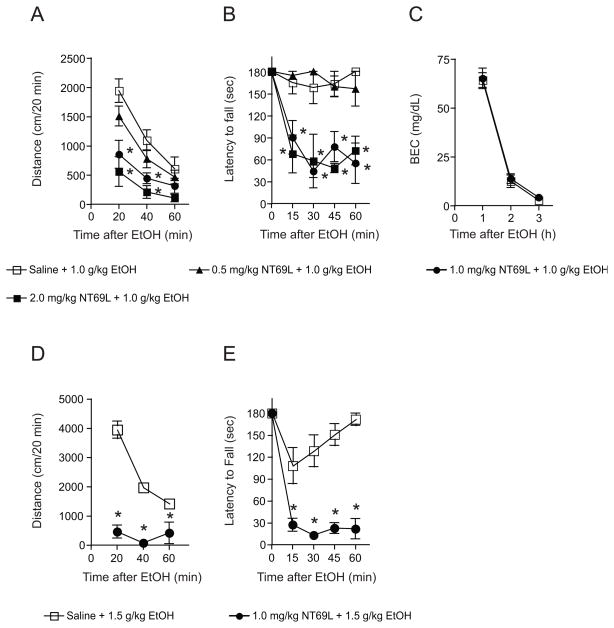Figure 3.
Effect of 1.0 g/kg ethanol on NT69L pretreated mice in open-field locomotor activity and rotarod ataxia experiments. (A) NT69L-treated mice traveled less in the open field activity compared to saline-treated mice in a dose-dependent fashion after ethanol administration (i.p.) to observe the effect of NT69L in ethanol-mediated spontaneous locomotor activity. The Tukey test showed reduced spontaneous locomotor activity from 20 min to 40 min (at 1.0 and 2.0 mg/kg NT69L + 1.0 g/kg ethanol) after NT69L administration in wild-type mice. (B) Dose-dependency of increased alcohol-induced ataxic responses of NT69L-treated wild-type mice. The Tukey test showed that NT69L treatment was effective from 15 min to 1 h after the ethanol treatment at doses of 1.0 mg/kg and 2.0 mg/kg NT69L. Conditions were 1.0 g/kg ethanol and various concentrations of NT69L (saline, 0.5, 1.0, and 2.0 mg/kg NT69L) for both experiments. n = 5–6 for each treatment. *p < 0.05 compared to the saline+ethanol-injected mice at the same time after injection. (C) No significant difference (p > 0.05 by Tukey test) between blood ethanol clearances after acute administration of NT69L. Conditions were 1.0 g/kg ethanol and 1.0 mg/kg NT69L for blood ethanol clearance experiment (n = 6). At 1.5 g/kg ethanol-injected mice showed sedative-like phenotype when pretreated with 1.0 mg/kg NT69L (n = 8) both in (D) locomotor activity and (E) ataxia compared to saline-treated mice (n = 8). *p < 0.05 by Tukey test. All data are expressed as mean ± s.e.m.

